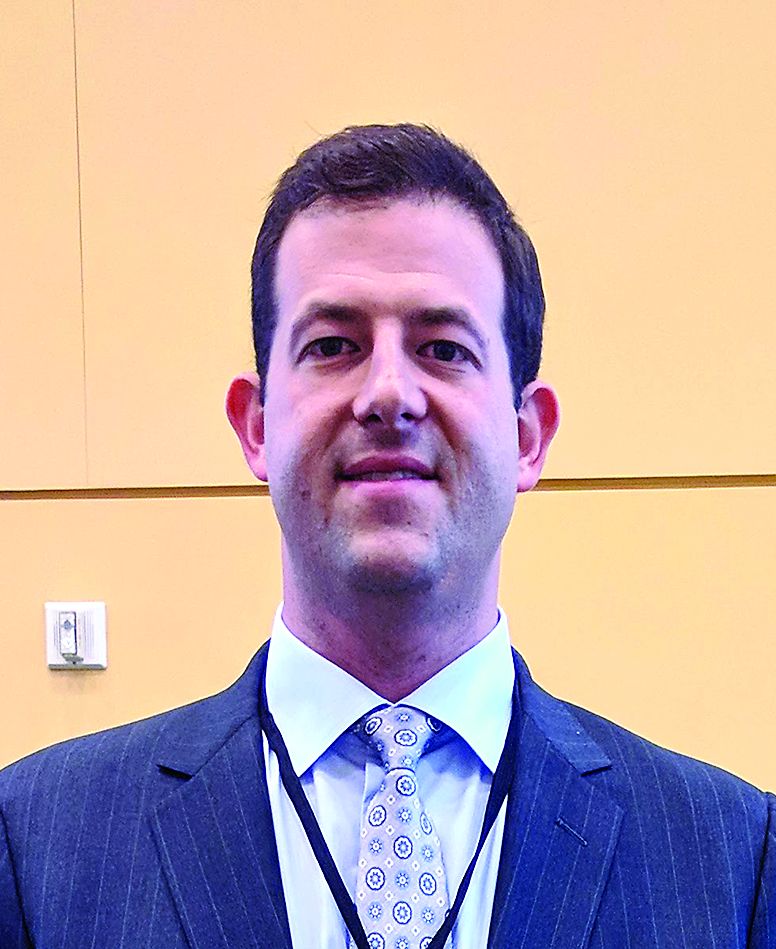User login
SAN FRANCISCO – Partial nephrectomy for localized renal cell carcinomas (RCCs) is on the rise, but the procedure is still less commonly performed than radical nephrectomy and more commonly performed at high-volume surgical centers.
About half of localized renal tumors are excised through partial nephrectomy, based on results from a new analysis of The National Cancer Database. The study also indicated that patient mortality rates were lower at high volume centers, those in the top 10 percentile of treatment volume, said David Cahn, DO, who presented the results at the annual meeting of the American Urological Association.
The study looked at surgeries among 142,000 patients with pT1a-T2b RCCs (no involvement of lymph nodes or metastases) who underwent procedures during 2004-2014.
Overall, 41% of patients had partial nephrectomies, 58% had radical nephrectomies, and 1% received ablative therapy. The frequency of partial nephrectomies rose markedly over the course of the study, increasing from 24% of cases in 2004 to 53% in 2014. The vast majority of partial nephrectomies, 81%, were performed for pT1a tumors; 24% of pT1b tumors also were excised using partial nephrectomy.
Compared with the reference point of T1a tumors, T1b tumors (odds ratio, 0.22; P less than .0001), T2a (OR, 0.06; P less than .0001), and T2b tumors (OR, 0.03; P less than .0001) were progressively less likely to be treated with partial nephrectomy. A multivariate analysis showed that patients at a high volume center were significantly more likely to undergo partial nephrectomy (OR, 1.89; P less than .0001). Overall mortality was lower at high volume centers (hazard ratio, 0.92; P = .012).
“I think that regionalization of care has ... some benefits to patients, but it comes with many challenges as well. This study really did help show that increased numbers [of procedures performed] makes you more comfortable and willing to offer partial nephrectomy,” said Dr. Cahn, of Fox Chase Cancer Center, Philadelphia.
“Volume tends to show better outcomes. But the concern is: Are you overloading systems? Are you making patients travel farther, and how does that work in terms of follow-up care?” Dr. Cahn said. He cited the example of a patient who may have to travel several hours to get surgery but then returns home and develops a postoperative complication that must be treated in a different facility. That raises issues of transfer of medical records and coordination of care.
The solution, he said, is for some of the procedures and practices common at high-volume centers to be transferred to smaller centers. “For the routine partial nephrectomy ... we need to have well-trained physicians who can offer those all over the country. I think it’s too hard in terms of feasibility to push those patients just towards certain high volume centers.”
SOURCE: AUA Annual Meeting, Abstract PD07-04.
SAN FRANCISCO – Partial nephrectomy for localized renal cell carcinomas (RCCs) is on the rise, but the procedure is still less commonly performed than radical nephrectomy and more commonly performed at high-volume surgical centers.
About half of localized renal tumors are excised through partial nephrectomy, based on results from a new analysis of The National Cancer Database. The study also indicated that patient mortality rates were lower at high volume centers, those in the top 10 percentile of treatment volume, said David Cahn, DO, who presented the results at the annual meeting of the American Urological Association.
The study looked at surgeries among 142,000 patients with pT1a-T2b RCCs (no involvement of lymph nodes or metastases) who underwent procedures during 2004-2014.
Overall, 41% of patients had partial nephrectomies, 58% had radical nephrectomies, and 1% received ablative therapy. The frequency of partial nephrectomies rose markedly over the course of the study, increasing from 24% of cases in 2004 to 53% in 2014. The vast majority of partial nephrectomies, 81%, were performed for pT1a tumors; 24% of pT1b tumors also were excised using partial nephrectomy.
Compared with the reference point of T1a tumors, T1b tumors (odds ratio, 0.22; P less than .0001), T2a (OR, 0.06; P less than .0001), and T2b tumors (OR, 0.03; P less than .0001) were progressively less likely to be treated with partial nephrectomy. A multivariate analysis showed that patients at a high volume center were significantly more likely to undergo partial nephrectomy (OR, 1.89; P less than .0001). Overall mortality was lower at high volume centers (hazard ratio, 0.92; P = .012).
“I think that regionalization of care has ... some benefits to patients, but it comes with many challenges as well. This study really did help show that increased numbers [of procedures performed] makes you more comfortable and willing to offer partial nephrectomy,” said Dr. Cahn, of Fox Chase Cancer Center, Philadelphia.
“Volume tends to show better outcomes. But the concern is: Are you overloading systems? Are you making patients travel farther, and how does that work in terms of follow-up care?” Dr. Cahn said. He cited the example of a patient who may have to travel several hours to get surgery but then returns home and develops a postoperative complication that must be treated in a different facility. That raises issues of transfer of medical records and coordination of care.
The solution, he said, is for some of the procedures and practices common at high-volume centers to be transferred to smaller centers. “For the routine partial nephrectomy ... we need to have well-trained physicians who can offer those all over the country. I think it’s too hard in terms of feasibility to push those patients just towards certain high volume centers.”
SOURCE: AUA Annual Meeting, Abstract PD07-04.
SAN FRANCISCO – Partial nephrectomy for localized renal cell carcinomas (RCCs) is on the rise, but the procedure is still less commonly performed than radical nephrectomy and more commonly performed at high-volume surgical centers.
About half of localized renal tumors are excised through partial nephrectomy, based on results from a new analysis of The National Cancer Database. The study also indicated that patient mortality rates were lower at high volume centers, those in the top 10 percentile of treatment volume, said David Cahn, DO, who presented the results at the annual meeting of the American Urological Association.
The study looked at surgeries among 142,000 patients with pT1a-T2b RCCs (no involvement of lymph nodes or metastases) who underwent procedures during 2004-2014.
Overall, 41% of patients had partial nephrectomies, 58% had radical nephrectomies, and 1% received ablative therapy. The frequency of partial nephrectomies rose markedly over the course of the study, increasing from 24% of cases in 2004 to 53% in 2014. The vast majority of partial nephrectomies, 81%, were performed for pT1a tumors; 24% of pT1b tumors also were excised using partial nephrectomy.
Compared with the reference point of T1a tumors, T1b tumors (odds ratio, 0.22; P less than .0001), T2a (OR, 0.06; P less than .0001), and T2b tumors (OR, 0.03; P less than .0001) were progressively less likely to be treated with partial nephrectomy. A multivariate analysis showed that patients at a high volume center were significantly more likely to undergo partial nephrectomy (OR, 1.89; P less than .0001). Overall mortality was lower at high volume centers (hazard ratio, 0.92; P = .012).
“I think that regionalization of care has ... some benefits to patients, but it comes with many challenges as well. This study really did help show that increased numbers [of procedures performed] makes you more comfortable and willing to offer partial nephrectomy,” said Dr. Cahn, of Fox Chase Cancer Center, Philadelphia.
“Volume tends to show better outcomes. But the concern is: Are you overloading systems? Are you making patients travel farther, and how does that work in terms of follow-up care?” Dr. Cahn said. He cited the example of a patient who may have to travel several hours to get surgery but then returns home and develops a postoperative complication that must be treated in a different facility. That raises issues of transfer of medical records and coordination of care.
The solution, he said, is for some of the procedures and practices common at high-volume centers to be transferred to smaller centers. “For the routine partial nephrectomy ... we need to have well-trained physicians who can offer those all over the country. I think it’s too hard in terms of feasibility to push those patients just towards certain high volume centers.”
SOURCE: AUA Annual Meeting, Abstract PD07-04.
REPORTING FROM THE AUA ANNUAL MEETING
Key clinical point: Many patients who could undergo partial nephrectomy are still receiving radical nephrectomies.
Major finding: In 2014, 53% of patients with pT1a or pT1b RCC underwent partial nephrectomy.
Study details: Retrospective analysis of 142,000 patients.
Disclosures: The study was funded internally. Dr. Cahn reports having no relevant financial disclosures.
Source: Cahn D et al. AUA Annual Meeting, Abstract PD07-04.

